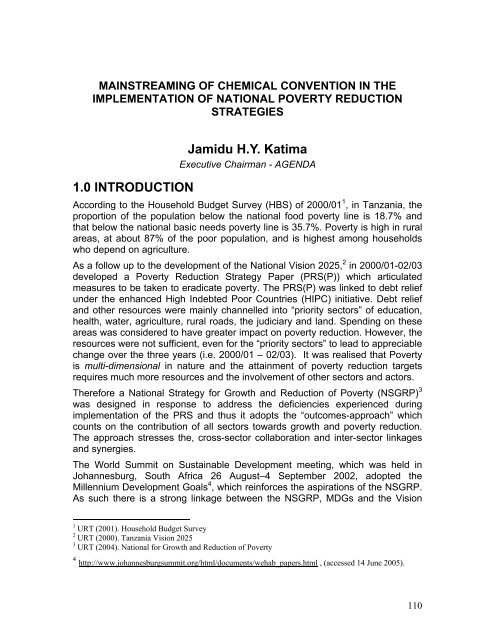Tanzania Multi Stakeholder Map - WebNG
Tanzania Multi Stakeholder Map - WebNG
Tanzania Multi Stakeholder Map - WebNG
Create successful ePaper yourself
Turn your PDF publications into a flip-book with our unique Google optimized e-Paper software.
MAINSTREAMING OF CHEMICAL CONVENTION IN THE<br />
IMPLEMENTATION OF NATIONAL POVERTY REDUCTION<br />
STRATEGIES<br />
1.0 INTRODUCTION<br />
Jamidu H.Y. Katima<br />
Executive Chairman - AGENDA<br />
According to the Household Budget Survey (HBS) of 2000/01 1 , in <strong>Tanzania</strong>, the<br />
proportion of the population below the national food poverty line is 18.7% and<br />
that below the national basic needs poverty line is 35.7%. Poverty is high in rural<br />
areas, at about 87% of the poor population, and is highest among households<br />
who depend on agriculture.<br />
As a follow up to the development of the National Vision 2025, 2 in 2000/01-02/03<br />
developed a Poverty Reduction Strategy Paper (PRS(P)) which articulated<br />
measures to be taken to eradicate poverty. The PRS(P) was linked to debt relief<br />
under the enhanced High Indebted Poor Countries (HIPC) initiative. Debt relief<br />
and other resources were mainly channelled into “priority sectors” of education,<br />
health, water, agriculture, rural roads, the judiciary and land. Spending on these<br />
areas was considered to have greater impact on poverty reduction. However, the<br />
resources were not sufficient, even for the “priority sectors” to lead to appreciable<br />
change over the three years (i.e. 2000/01 – 02/03). It was realised that Poverty<br />
is multi-dimensional in nature and the attainment of poverty reduction targets<br />
requires much more resources and the involvement of other sectors and actors.<br />
Therefore a National Strategy for Growth and Reduction of Poverty (NSGRP) 3<br />
was designed in response to address the deficiencies experienced during<br />
implementation of the PRS and thus it adopts the “outcomes-approach” which<br />
counts on the contribution of all sectors towards growth and poverty reduction.<br />
The approach stresses the, cross-sector collaboration and inter-sector linkages<br />
and synergies.<br />
The World Summit on Sustainable Development meeting, which was held in<br />
Johannesburg, South Africa 26 August–4 September 2002, adopted the<br />
Millennium Development Goals 4 , which reinforces the aspirations of the NSGRP.<br />
As such there is a strong linkage between the NSGRP, MDGs and the Vision<br />
1 URT (2001). Household Budget Survey<br />
2 URT (2000). <strong>Tanzania</strong> Vision 2025<br />
3 URT (2004). National for Growth and Reduction of Poverty<br />
4 http://www.johannesburgsummit.org/html/documents/wehab_papers.html , (accessed 14 June 2005).<br />
110
















